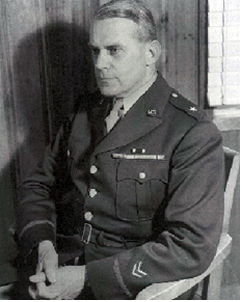Brigadier General
Donald J. Armstrong
 Donald J. Armstrong
began his military career as an Army Coast Defense Artillery lieutenant after completing his masters degree
at Columbia University in 1910.
Donald J. Armstrong
began his military career as an Army Coast Defense Artillery lieutenant after completing his masters degree
at Columbia University in 1910.
During World War I, he served as an artillery officer in the American Expeditionary Forces. Then he was assigned as an assistant military attaché in the American Embassy in Paris from 1919 to 1924.
He transferred to the Ordnance Department in 1923 and was assigned first to the research laboratory at Watertown Arsenal, then as a War Department planner, a member of the Field Artillery Board, and as Chief of the Maintenance Division in the Office of the Chief of Ordnance.
These demanding assignments provided a thorough grounding in research, development, industrial operations, and maintenance that would serve him well in the key positions he held during World War II.
From 1939 to 1942, he served as Executive Officer and then Chief of the Chicago Ordnance District, coordinating industrial mobilization and wartime production in a region covering all or part of eight Midwestern states. While he was assigned to the Chicago District, it awarded $2.7 billion dollars in Ordnance Department contracts.
Next, he took command of the newly established Tank-Automotive Center in Detroit, which would later become the Tank-Automotive Command. The new center had broad responsibilities for procuring the Army's tanks and automotive equipment.
In December 1942, he moved on to a new challenge--command of the Ordnance Replacement Training Center (ORTC) at Aberdeen Proving Ground, which trained all of the Ordnance Department's individual replacements. Armstrong reorganized the still-expanding center to into three training regiments that provided sequential basic and advanced training to as many as 14,000 soldiers at a time and graduated up to three companies of replacements each week. He also established a Field Training Battalion that conducted a three-week field training exercise for all of the trainees at Camp Pickett, VA.
In August 1944, BG Armstrong was appointed Commandant of the Army Industrial College. Much to his credit, he was instrumental in converting it to a joint-services institution, the Industrial College of the Armed Forces (ICAF). During his tenure, 1,600 Naval officers became part of the student body and graduated from ICAF.
BG Armstrong retired in 1946 after 35 years of distinguished military service and 23 years as an Ordnance officer. He died in January 1984.